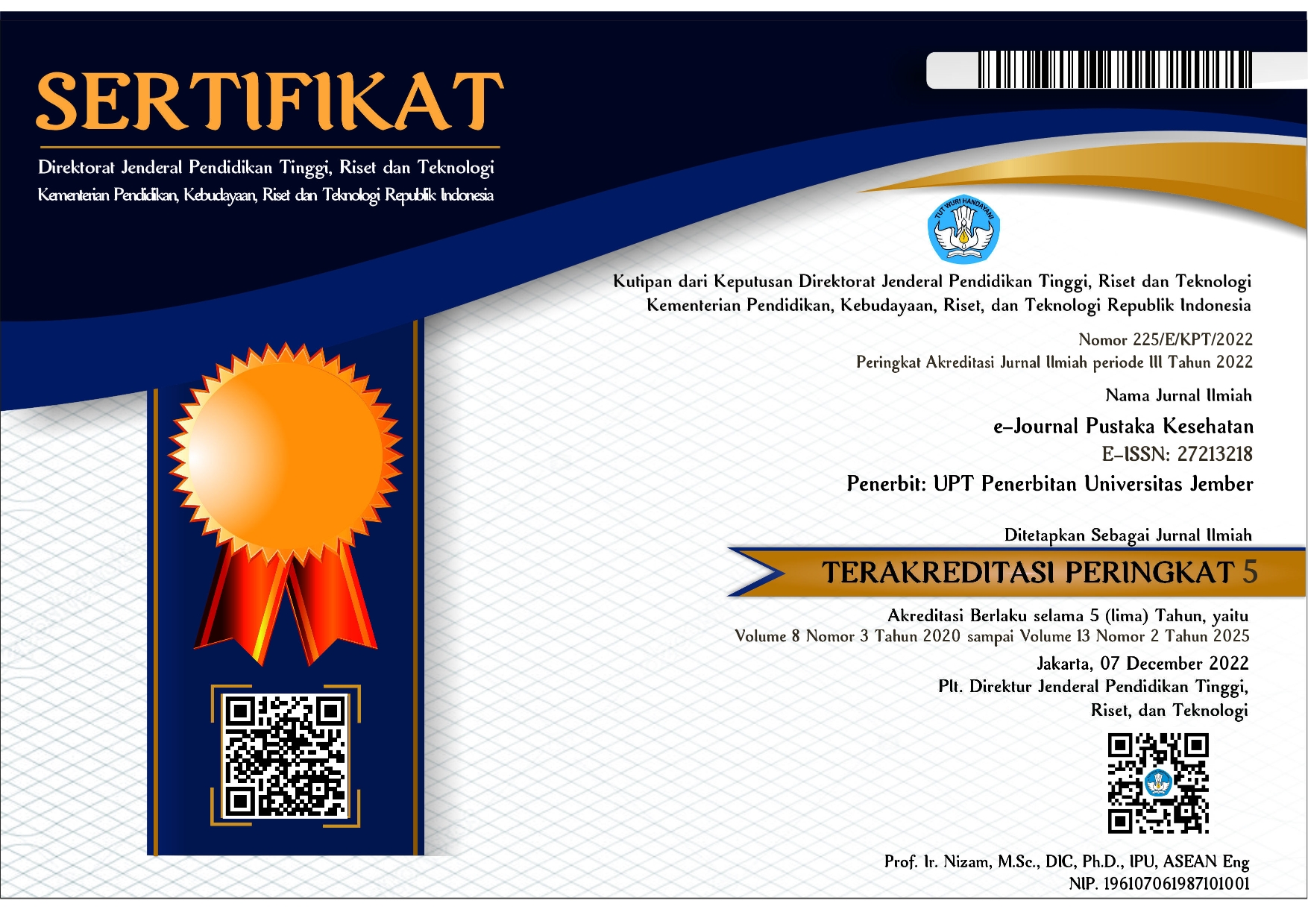Efektivitas Penggunaan ITN (Insecticide Treated Nets) terhadap Penurunan Kasus Malaria pada Anak di Bawah 5 Tahun di Indonesia
Keywords:
Malaria, Children under 5 years old, ITN (Insecticide-Treated Nets), IndonesiaAbstract
Malaria is caused by the Plasmodium parasite and is transmitted through the bites of infected Anopheles mosquitoes, which are prevalent in tropical regions, including Indonesia. In 2010, Indonesia recorded 465.7 thousand positive malaria cases, but this number decreased to 235.7 thousand in 2020. Additionally, the Annual Parasite Incidence (API) also showed a decline from 1.96 in 2010 to 0.87 in 2020. Various preventive measures have been implemented, including the use of Insecticide-Treated Nets (ITN). This research employed a literature review method with the PRISMA (Preferred Reporting Items for Systematic Review & Meta-Analysis) approach, gathering data from international journal sources such as Google Scholar and PubMed, comprising a total of 13 journal articles. The study found that ITNs can reduce the incidence of malaria, particularly among children under five years old in Indonesia. The government's program for distributing ITNs has proven effective in decreasing malaria cases. Health workers, community health volunteers, and community-based health service centers play a crucial role in disseminating information, distributing, and promoting the use of ITNs. Based on the literature review, it was concluded that the use of ITNs is effective in reducing malaria cases in children under 5 years old in Indonesia.
Downloads
References
[1] WHO. Fact sheet about malaria, World Health Organization. 2023. Available at: https://www.who.int/news-room/fact-sheets/detail/malaria (Accessed: 22 October 2023).
[2] Kementerian Kesehatan. Kasus malaria di Indonesia Menurun, NTT Jadi Provinsi Pertama di Kawasan Timur berhasil eliminasi malaria, P2P Kemenkes RI. 2021. Available at: http://p2p.kemkes.go.id/kasus-malaria-di-indonesia-menurun-ntt-jadi-provinsi-pertama-di-kawasan-timur-berhasil-eliminasi-malaria/ (Accessed: 22 October 2023).
[3] CDC-Parasites-Malaria, Centers for Disease Control and Prevention. 2023a. Available at: https://www.cdc.gov/parasites/malaria/index.html (Accessed: 22 October 2023).
[4] WHO. Malaria. 2023. [online] Who.int. Available at: https://www.who.int/news-room/fact-sheets/detail/malaria.
[5] WHO. WHO publishes recommendations on two new types of insecticide-treated nets. 2023. [online] www.who.int. Available at: https://www.who.int/news/item/14-03-2023-who-publishes-recommendations-on-two-new-types-of-insecticide-treated-nets.
[6] Lover AA, Sutton BA, Asy AJ, Wilder-Smith A. An exploratory study of treated-bed nets in timor-leste: Patterns of intended and alternative usage, Malaria journal. 2011. 10: 199. Available at: https://www.ncbi.nlm.nih.gov/pmc/articles/PMC3155971/ (Accessed: 26 September 2023).
[7] Sungkar S, Fathurrahman D, Buntaran S. Kekalih A. Contribution of a program of insecticide treated nets for reducing malaria prevalence in Kori Subdistrict, Southwest Sumba, Journal of Natural Science, Biology and Medicine (suppl), 2019. 10(3). 78-81.
[8] Bandzuh JT, Ernst KC, Gunn JK, Pandarangga S, Yowi LRK, Hobgen S, et al. Knowledge, attitudes, and practices of anopheles mosquito control through insecticide treated nets and community-based health programs to prevent malaria in East Sumba Island, Indonesia, PLOS global public health. 2022. 2(9): e0000241. Available at: https://pubmed.ncbi.nlm.nih.gov/36962713/ (Accessed: 23 October 2023).
[9] Selvia D. Outdoors Activity on the Night and Use of Insecticidal Nets with Malaria Disease in Lempasing Village. Jurnal Ilmiah Kesehatan (JIKA) 2019. 1(2): 89–95. doi:10.36590/jika.v1i2.29.
[10] Walidiyati AT. (2019). Hubungan Perilaku Penggunaan Kelambu Berinsektisida dengan Kejadian Malaria di Desa Rindi Wilayah Kerja Puskesmas Tanaraing Kabupaten Sumba Timur. CHMK Applied Scientific Journal, 2019. 2(3): 93-97.
[11] Narsono N, Mirasa YA, Setiawan A, Sriwahyuni E, Sunardi S. Analisis Penggunaan Kelambu Berinsektisida di Kabupaten Trenggalek, Human Care Journal 2023. 8(2): 425–433. doi:2528-665X.
[12] Ulviana NI, Martini M, Kusariana N, Wuryanto A. Praktik Penggunaan Kelambu Berinsektisida dan Insektisida Rumah Tangga Berbahan Aktif Piretroid di Daerah Fokus Malaria Kabupaten Purworejo (Studi di Desa Kaliharjo, Kecamatan Kaligesing, Kabupaten Purworejo). Jurnal Ilmiah Mahasiswa, 2021. 11(1): 6-10.
[13] Siregar PA, Saragih ID. Faktor Risiko malaria Masyarakat Pesisir di kecamatan Pantai Cermin Kabupaten Serdang Bedagai. Tropical Public Health Journal, 2021. 1(2): 50–57. doi:10.32734/trophico.v1i2.7261.
[14] Soenjono SJ, Layuk S, Makaraki FR. Penggunaan Kelambu Terhadap Kejadian Malaria di Kabupaten Kepulauan Talaud. E-Prosiding Semnas Polkesdo. 2022. 1(02): 422-429. ISSN 978.623.93457.1.6
[15] Purwanto AA. The Differences of Community Knowledge Between Before and After Education of Long Lasting Insecticide Net as A Preventive Program Against Malaria Diseases in Suka Jaya Village Lempasing Pesawaran Lampung. Universitas Lampung. 2018. Lampung.
[16] Sihite JS. 2022. Hubungan Kepatuhan Menggunakan Kelambu Berinsektisida dengan Kejadian Penyakit Malaria Kelurahan Pasir Bidang Tahun 2021. Journal of Inovation Research and Knowledge.2022. 1(11): 1569-1576.
[17] Dewi HM. Hubungan antara penggunaan kelambu berinsektisida terhadap angka kejadian infeksi malaria di Puskesmas Kecamatan Kacang Pedang. Universitas trisakti. 2020. Jakarta.
[18] Bonlay M, Sirait R, Littik SKA. Efektivitas Program Kelambunisasi di Puskesmas Oesapa Kecamatan Kelapa Lima Kota Kupang. Lontar: Journal of Community health. 2019. 1(1): 2685-2438.
[19] Umasugi MT, Sillehu S, Sely MD, Fitriasari E. Strategi Edukasi Pemanfaatan Kelambu sebagai Upaya Pencegahan Malaria di Desa Hualoy, Kabupaten Seram Bagian barat. Jurnal Pengabdian kepada Msayrakat Radisi. 2021. 192): 36-40.
Downloads
Published
Issue
Section
License
Copyright (c) 2025 e-Journal Pustaka Kesehatan

This work is licensed under a Creative Commons Attribution-ShareAlike 4.0 International License.
e-Journal Pustaka Kesehatan has CC-BY-SA or an equivalent license as the optimal license for the publication, distribution, use, and reuse of scholarly work. Authors who publish with this journal retain copyright and grant the journal right of first publication with the work simultaneously licensed under a Creative Commons Attribution-ShareAlike 4.0 International License that allows others to share the work with an acknowledgment of the work's authorship and initial publication in this journal.







